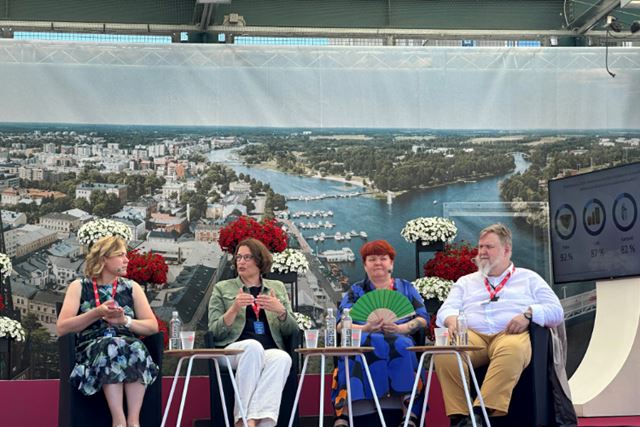
How can we collectively accelerate the recycling of packaging? What kinds of packaging are sustainable for the future? And how can we make recycling more convenient for consumers? These key questions, among others, were explored during Huhtamaki's panel discussion at the SuomiAreena societal discussion festival in Pori, Finland, in late June.
How food is packaged and what happens to the packaging afterward have significant global impacts. In the SuomiAreena panel discussion Henna Virkkunen, Member of the European Parliament (MEP) and candidate for commissioner, Ali Harlin, research professor at the VTT Technical Research Centre of Finland, Nina Elomaa, Chief Sustainability Officer at SOK (S-ryhmä / S-group), and Salla Ahonen, Executive Vice President of Sustainability and Communications at Huhtamaki, shared valuable insights on sustainable packaging and how to accelerate packaging recycling. They agreed that there is no single solution that fits all; instead, the entire value chain must collaborate to build a functioning circular system.
Reusing material locally
Henna Virkkunen stressed the need for a sustainable economic model on multiple levels and highlighted the importance of self-sufficiency. By avoiding waste of raw materials and leveraging local resources, we can mitigate the risks associated with long and complex supply chains.
“We need to achieve a more sustainable economic model from economic, environmental and social perspectives. Currently, we in Finland and Europe are dependent on various imported raw materials, which is an unsustainable model for the future. We constantly need new fossil raw materials that we use and then discard. It is sensible to reuse raw materials as efficiently as possible to ensure no waste is generated in the future,” she emphasized.
Convenience is critical
The panel discussion presented recent findings from a consumer survey on packaging material recycling. Commissioned by Huhtamaki and conducted by the independent research company Aula Research, the survey revealed that 80% of Finnish consumers are satisfied with their recycling habits. However, the actual recycling rate stands at approximately 40%. This gap highlights the need to make recycling more convenient and user-friendly for consumers.
“When recycling is easy and accessible, individuals are more likely to participate. If it’s straightforward to sort waste and transport it to a recycling point, people will do it. Convenience in daily life is the critical factor,” reminded Nina Elomaa.
The panelists stressed that eliminating packaging is not a feasible option and highlighted the primary function of packaging: protecting the products. Fit-for-purpose packaging safeguards food during transport and extends its shelf life, thereby helping to prevent food waste, which globally contributes to approximately 10 percent of total greenhouse gas emissions.
The importance of innovations
Collection infrastructure and distances play a key role in how convenient it is for consumers to recycle. Clear instructions and labelling on packaging are also crucial to help consumers sort their packaging correctly after use. A third key aspect is packaging design, which significantly influences recycling efficiency. For example, packaging made from multiple layers of different plastics is challenging to recycle using traditional methods.
“By innovating in packaging design and recycling technologies, we can make it possible to recycle a broader range of products efficiently. At Huhtamaki, we are for instance developing flexible monomaterial packaging, removing multiple layers and aluminum to facilitate recycling,” said Salla Ahonen.
Ali Harlin envisioned a near future where advanced technology will facilitate the proper sorting of materials, such as plastic packaging, and improve the quality of recycled materials.
“Before we can achieve automated sorting, we need extensive innovation, start-ups, and investments to drive progress. A chain isn't complete until all its links are in place, and that's why we must patiently build the system from every angle."
